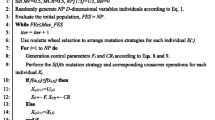Abstract
This paper proposes a new differential evolution (DE) algorithm for unconstrained continuous optimisation problems, termed \(\mu \)JADE, that uses a small or ‘micro’ (\(\mu \)) population. The main contribution of the proposed DE is a new mutation operator, ‘current-by-rand-to-pbest.’ With a population size less than 10, \(\mu \)JADE is able to solve some classical multimodal benchmark problems of 30 and 100 dimensions as reliably as some state-of-the-art DE algorithms using conventionally sized populations. The algorithm also compares favourably to other small population DE variants and classical DE.


Similar content being viewed by others
References
Brest J, Maučec M (2011) Self-adaptive differential evolution algorithm using population size reduction and three strategies. Soft Comput 15:2157–2174
Choi T, Ahn C (2014) An adaptive differential evolution algorithm with automatic population resizing for global numerical optimization. In: Pan L, Pǎun G, Pérez-Jiménez M, Song T (eds) Bio-Inspired Computing– Theories and Applications, Communications in Computer and Information Science, vol 472, Springer, pp 68–72
Das S, Suganthan P (2011) Differential evolution: a survey of the state-of-the-art. IEEE Trans Evolut Comput 15:4–31
Fajfar I, Puhan J, Tomažič S, Bűrmen A (2011) On selection in differential evolution. Elektrotehniški Vestnik 78:275–280
Fajfar I, Tuma T, Puhan J, Olenšek J, Bűrmen A (2012) Towards smaller populations in differential evolution. J Microelectron Electron Compon Mater 42:152–163
Gong W, Cai Z (2013) Differential evolution with ranking-based mutation operators. IEEE Trans Cybern 43:2066–2081
Gong W, Cai Z, Ling C (2011a) De/bbo: a hybrid differential evolution with biogeography-based optimization for global numerical optimization. Soft Comput 15:645–665
Gong W, Cai Z, Ling C, Li H (2011b) Enhanced differential evolution with adaptive strategies for numerical optimization. IEEE Trans Syst Man Cybern Part B Cybern 41:397–413
Gong W, Cai Z, Wang Y (2014) Repairing the crossover rate in adaptive differential evolution. Appl Soft Comput 15:149–168
Kazimipour B, Li X, Qin A (2014) Effects of population initialization on differential evolution for large scale optimization. In: 2014 IEEE Congress on Evolutionary Computation, pp 2404–2411
Lampinen J, Zelinka I (2000) On stagnation of the differential evolution algorithm. In: 6th International Conference on Soft Computing MENDEL, pp 76–83
Mallipeddi R, Suganthan P (2008) Empirical study on the effect of population size on differential evolution algorithm. In: The 2008 IEEE Congress on Evolutionary Computation, pp 3663–3670
Mendes R, Mohais A (2005) DynDE: a differential evolution for dynamic optimization problems. In: The 2005 IEEE Congress on Evolutionary Computation, vol 3, pp 2808–2815
Mininno E, Neri F, Cupertino F, Naso D (2011) Compact differential evolution. IEEE Trans Evol Comput 15:32–54
Montgomery J, Chen S (2010) An analysis of the operation of differential evolution at high and low crossover rates. In: 2010 IEEE Congress on Evolutionary Computation, pp 1–8
Ren X, Chen Z, Ma Z (2010) Differential evolution using smaller population. In: 2010 Second International Conference on Machine Learning and Computing, pp 76–80
Ronkkonen J, Kukkonen S, Price K (2005) Real-parameter optimization with differential evolution. In: The 2005 IEEE Congress on Evolutionary Computation, vol 1, pp 506–513
Salehinejad H, Rahnamayan S, Tizhoosh H, Chen S (2014) Micro-differential evolution with vectorized random mutation factor. In: 2014 IEEE Congress on Evolutionary Computation, pp 2055–2062
Sharma H, Shrivastava P, Bansal J, Tiwari R (2014) Fitness based self adaptive differential evolution. In: Terrazas G, Otero F, Masagosa A (eds) Nature Inspired Cooperative Strategies for Optimization (NICSO 2013), Studies in Computational Intelligence, vol 512, Springer, pp 71–84
Storn R, Price K (1997) Differential evolution—a simple and efficient heuristic for global optimization over continuous spaces. J Glob Optim 11:341–359
Teng N, Teo J, Hijazi M (2009) Self-adaptive population sizing for a tune-free differential evolution. Soft Comput 13:709–724
Teo J (2006) Exploring dynamic self-adaptive populations in differential evolution. Soft Comput 10:673–686
Wang X, Zhao S (2013) Differential evolution algorithm with self-adaptive population resizing mechanism. Math Probl Eng 419372
Wang Y, Cai Z, Zhang Q (2011) Differential evolution with composite trial vector generation strategies and control parameters. IEEE Trans Evol Comput 15:55–66
Yang M, Cai Z, Li C, Guan J (2013) An improved adaptive differential evolution algorithm with population adaptation. In: Proceedings of the 15th Annual Conference on Genetic and Evolutionary Computation, pp 145–152
Yao X, Liu Y, Lin G (1999) Evolutionary programming made faster. IEEE Trans Evol Comput 3:82–102
Yu X, Huang D, Wang X, Jin Y (2008) DE-based neural network nonlinear model predictive control and its application for the pH neutralization reactor control. Chin Control Decis Conf 2008:1597–1602
Zhang J, Sanderson A (2009a) Adaptive differential evolution: a robust approach to multimodal problem optimization adaptation learning and optimization. Springer, Berlin
Zhang J, Sanderson A (2009b) JADE: Adaptive differential evolution with optional external archive. IEEE Trans Evolut Comput 13:945–958
Zhao S, Wang X, Chen L, Zhu W (2014) A novel self-adaptive differential evolution algorithm with population size adjustment scheme. Arab J Science Eng 39:6149–6174
Acknowledgments
The authors would like to thank the anonymous reviewers for helping to improve this paper.
Author information
Authors and Affiliations
Corresponding author
Additional information
Communicated by V. Loia.
This work was funded by Bosch Thermotechnology Ltd. and the Engineering and Physical Sciences Research Council (EPSRC) UK.
Rights and permissions
About this article
Cite this article
Brown, C., Jin, Y., Leach, M. et al. \(\mu \)JADE: adaptive differential evolution with a small population. Soft Comput 20, 4111–4120 (2016). https://doi.org/10.1007/s00500-015-1746-x
Published:
Issue Date:
DOI: https://doi.org/10.1007/s00500-015-1746-x




